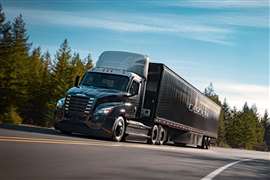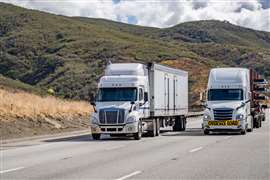6 things OEMs should know about CARB’s proposed Tier 5 rule
14 February 2024
CARB’s proposed emissions standard is all abouit reducing NOx and PM as well as addressing GHG emissions, among other things.
While currently in the development stage, the California Air Resources Board (CARB) staff is proposing amendments to current off-highway diesel emissions standards that it is calling Tier 5. According to the CARB website, the new standard “aims to reduce oxides of nitrogen (NOx) and particulate matter (PM) emissions from new, off‑road compression-ignition (CI) engines” compared to current Tier 4 Final emissions standards. On the website, the board said it plans to review a formal Tier 5 proposal in 2025 with an eye for implementation beginning in 2029.
AEM recently published an article on its website about what Tier 5 could mean for OEMs. The association based its assessment in part on a recent AEM member education webinar about the potential standard conducted by Steve Neva, North America director of International Standards and Regulations for Doosan Bobcat. Here are six key takeaways from the AEM’s outlook.
1. NOx & PM emissions must be significantly reduced
According to AEM, Tier 5 would see even tighter emissions limits than the European Union’s (EU) Stage 5 requirements:
- NOx emissions reduced by another 90 percent in the 56-560 kW power category
- PM reduced by another 50-75 percent in all power categories except for engines greater than 560 kW used in mobile machinery.
According to Neva, complying with such standards may mean redesigning equipment for aftertreatment devices that are either larger or more numerous, AEM said, while also allowing for additional cooling.
2. There will be new GHG standards
AEM said CARB is also proposing greenhouse gas (GHG) limits for power categories 19 kW and above. This will include limits for CO2, nitrous oxide (N2O) and methane (CH4).
For CO2, the proposed limits will vary by power category and are expected to apply as follows:
- 19-56 kW: CO2 capped at 80th percentile of CO2 emissions at Tier 4 Final levels.
- 56-560 kW: CO2 to be reduced by 6 percent from baseline.
- 560+ kW: CO2 capped at 80th percentile of CO2 emissions at Tier 4 Final levels
3. Aftertreatment systems will have added scrutiny
In addition to any new aftertreatment that may be required to comply with Tier 5, AEM said CARB is focused on ensuring all aftertreatment systems operate as intended.
For selective catalytic reduction (SCR) inducements, Tier 5 could codify what to date has only been “guidance” provided by the U.S. Environmental Protection Agency (EPA), AEM said. This could require changes to engines and equipment, such as warning lights and audible alarms in low-diesel exhaust fluid (DEF) situations or if the system is tampered with.
4. Idling emissions will be an additional focus
According to AEM, CARB data indicates that off-highway engines idle 30-50 percent of the time. As such, Tier 5 will take steps to address emissions related to engine idling.
For engines in the 56-560 kW range, CARB has developed a new low-load test cycle that includes an extended idle period. According to AEM, this may require engine manufacturers to implement more complex aftertreatment systems.
Furthermore, Tier 5 will include an idle NOx standard, AEM said. The aforementioned low-load test cycle will satisfy this requirement for engines the 56-560 kW range. All other power categories, however, will have to comply with the standard by reaching a pre-determined temperature at 3.5% rated power for 30 minutes and meet the NOx emissions requirement for its power category. If the engine fails, it will require a shutdown system.
5. Additional engine data will be required
Some aspects of Tier 5 will require extensive gathering of data, AEM said:
- All Tier 5 engines will be required to have an electronic control unit (ECU) to meet certain diagnostic requirements.
- Engines having an SCR must also have an onboard monitoring and diagnostics (OBMD) system. An on-board diagnostic (OBD) system will suffice for engines without an SCR.
- New Off-Road In-Use Testing (ORIUT) will be required for 56-560 kW engines to demonstrate and report annually on real-world, in-use emission control of NOx and PM.
6. Warranty and recall terms will be adjusted
As part of Tier 5, AEM said CARB proposes to increase an engine’s useful life and warranty timeframe by roughly 50%, adding that engine hours will not change. “For example, variable-speed engines of 37 kW and above will see their useful life increase from 10 to 15 years, and their warranty period extend from five to eight years,” the association said.
CARB is also proposing to extend the minimum maintenance interval for the exhaust gas recirculation (EGR) cooler from 1,500 hours to 3,000 hours for engines below 130 kW and 4,500 hours for engines 130 kW and above.
AEM said other warranty-related changes CARB is proposing include “any emission-related component with a minimum maintenance interval that is shorter than the warranty period will need to be covered through the entire warranty period.” It is also proposing recalls when aftertreatment devices fail. This would include onboard computers, urea dozers and hydrocarbon injectors, the association said.
Finally, for large-volume products, CARB is proposing a reduction in the threshold for addressing defects, AEM said. For example, the Tier 5 rule proposes dropping the current Tier 4 corrective action threshold for machines under 560 kW from the greater of 50 engines or 4 percent to 12 engines or 4 percent.
STAY CONNECTED




Receive the information you need when you need it through our world-leading magazines, newsletters and daily briefings.
POWER SOURCING GUIDE
The trusted reference and buyer’s guide for 83 years
The original “desktop search engine,” guiding nearly 10,000 users in more than 90 countries it is the primary reference for specifications and details on all the components that go into engine systems.
Visit Now
CONNECT WITH THE TEAM












